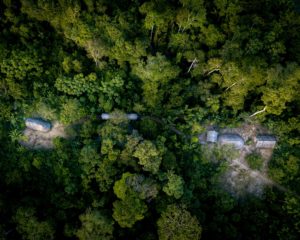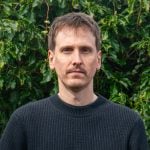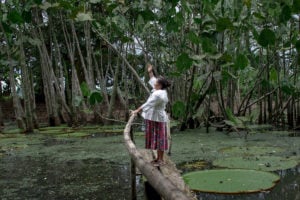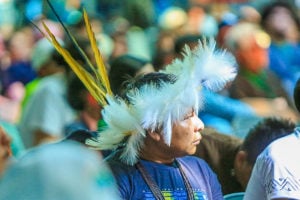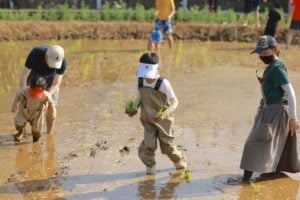The head of the world’s largest multilateral fund for environmental action has said the international community must find a “new paradigm” in climate and biodiversity finance that increases direct access to funding for Indigenous and local communities.
Carlos Manuel Rodríguez, CEO of the Global Environment Facility (GEF), made the call as delegates from 185 donor countries gathered for the GEF Assembly in Vancouver, Canada, alongside finance, business and civil society leaders.
Increasing international funding for environmental protection is the primary focus of the five-day meeting, the seventh assembly of the GEF, which has provided more than US$23 billion in grants to developing countries since its launch in 1992.
For Rodríguez, however, it’s not just a matter of getting more money. At the assembly’s opening on Tuesday 22, he said countries must also reconsider how they allocate resources, calling for an increase in direct funding for people on the ground who are already protecting nature.
Globally, less than 1% of foreign aid to address climate change goes directly to Indigenous and local communities, or projects to support their land tenure and forest management. This is despite studies that have shown the important role they have in driving effective and equitable conservation and environmental protection.
“We recognise the role [these communities] play and GEF wants to provide more funds for them,” Rodríguez said.
GEF funding is provided by donor countries and made available to developing countries through government agencies, companies and research institutions. Only 1% of its grants and funding is directly given to civil society, Rodríguez said, a figure that he hopes will reach 10% by 2030.
The facility’s direct funding mainly comes through its Small Grants Programme, which started over 30 years ago and has provided a combined US$725 million to more than 26,000 projects around the world. In Ecuador, for example, GEF has funded conservation initiatives for Indigenous and local communities, as well as work to help develop economic activities that use local biodiversity sustainably.
Darío Mejía Montalvo, chair of the UN Permanent Forum on Indigenous Issues, said at a side event in Vancouver that funding for environmental protection tends to go to organisations that can meet legal and financial requirements, but which are not familiar with the territories that they will be working in. This then risks funding not reaching Indigenous communities, he added.

“We need Indigenous communities to generate their own capacities to be independent of the financial system that is largely based on individualism, competition and speculation,” Mejía Montalvo said. He added that if the current approach to finance for these communities is not reassessed, there is a risk of a continued dependence on mechanisms “based on market rules” that can impose a “change in the value systems of Indigenous communities.”
An alternative approach
It is estimated that Indigenous peoples and local communities currently occupy, own or manage at least half of the world’s land area, with about 40% of those landscapes protected or classified as in good ecological condition. Indigenous people are thought to protect 80% of the world’s remaining biodiversity, despite comprising just 6% of the global population.
These communities are protectors of the planet, but face many challenges such as disease outbreaks, human rights violations, violence, lack of tenure on their land, and financial limitations.
At the UN’s COP26 climate summit in 2021, world leaders pledged US$1.7 billion to support Indigenous peoples and local communities in environmental protection, and their role in meeting global forest targets for 2030. But ensuring this funding reaches these groups could mean overcoming long-standing practices for channelling finance.
Research by the Rainforest Foundation Norway found that of the US$2.7 billion pledged to support Indigenous peoples and local communities’ tenure and forest management between 2011 and 2020, just 17% went to projects actually led by these communities or their organisations.
The foundation’s study found that over half of this funding was distributed via five organisations – the World Bank, African Development Bank, Inter-American Development Bank, Asian Development Bank and the UN Development Programme. The other half came through a mix of UN agencies, NGOs and consulting companies.
This intermediary approach frequently leads to funding not actually reaching communities. Seeking a way forward, many Indigenous and local community organisations are now addressing the problem by creating their own funding mechanisms. For example, Shandia, a finance platform created by the Global Alliance of Territorial Communities, hopes to raise and directly distribute US$300 million over the next decade.
In Latin America, the Mesoamerican Alliance of Peoples and Forests, a land rights platform for Indigenous organisations in Mexico and Central America, has spent several years developing a direct finance mechanism. The alliance is now working to capitalise the fund, targeting US$50 million over the next five years, which it says it will use to finance 10 large and 50 small community projects that will benefit approximately 5 million people in the region.
The funds currently go through many intermediaries and organisations, they are very fragmentedMaría Pia Hernández, manager of the Mesoamerican Alliance fund
“The funds currently go through many intermediaries and organisations; they are very fragmented,” María Pia Hernández, the Mesoamerican fund’s manager, said at a side event at GEF assembly. “The problem is not only how much money actually reaches communities, but also that there’s a lack of participation from them as final beneficiaries.”
Indigenous and local communities also face many barriers within the countries they live in, which tend to have complex requirements and laws that restrict funding from being released to them via international institutions. Communities also frequently lack the legal status or capacity to receive and manage large funds, and live in remote areas of their countries where there are often no banks.
Hernández called for work to strengthen the governance capacities of Indigenous and community organisations, acknowledging that many have weaknesses that block them from administering large funds and meeting the requirements of donors. She added that these groups need training and support, and should not be asked the same requirements as other implementing organisations.
The GEF Assembly runs from 22–26 August, with the headline act expected to be the launch of the Global Biodiversity Framework Fund, first announced at last December’s COP15 biodiversity summit in Montreal.
This story was produced with the support of Internews’ Earth Journalism Network.
